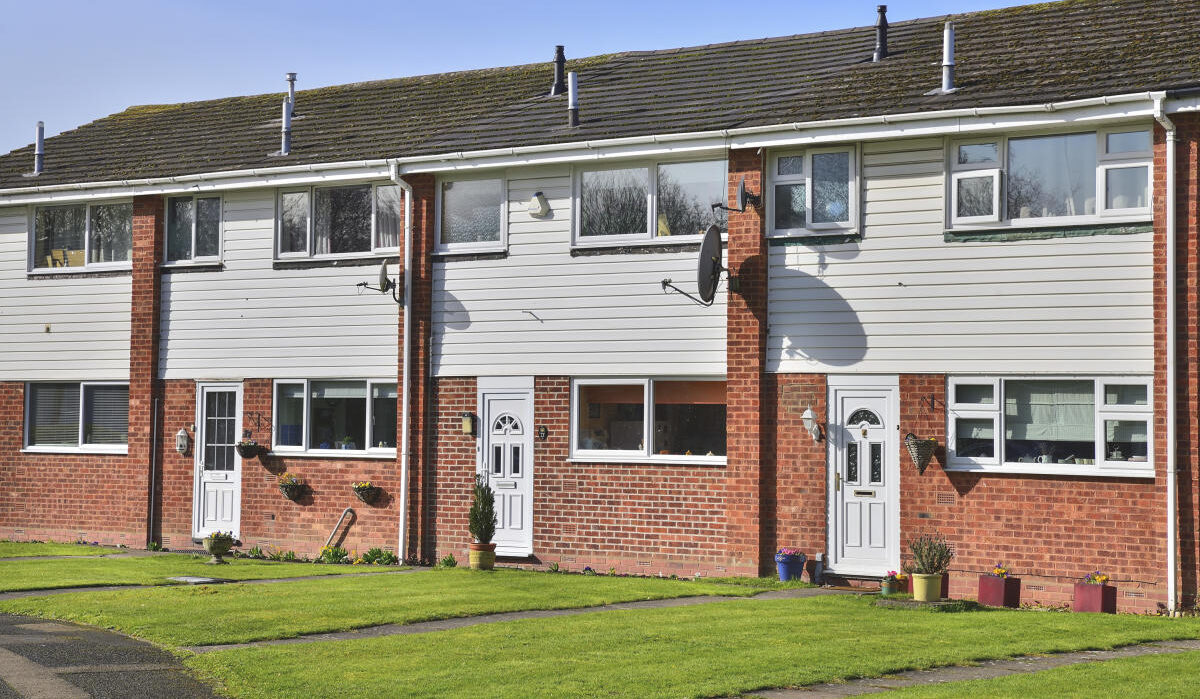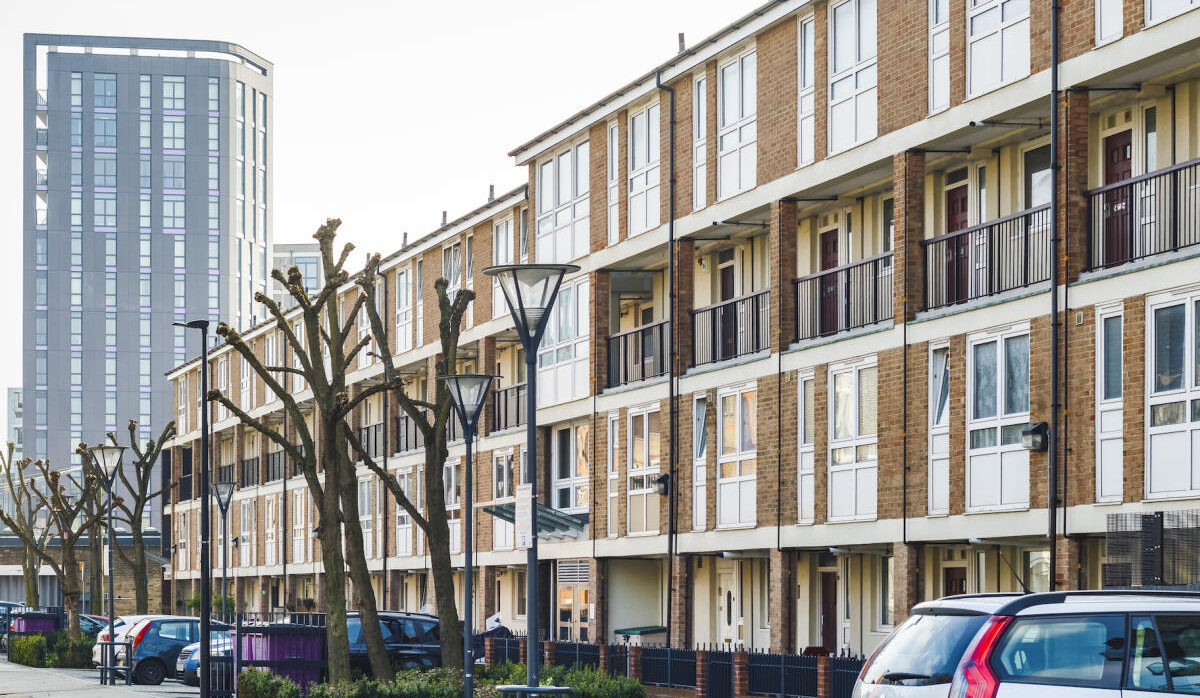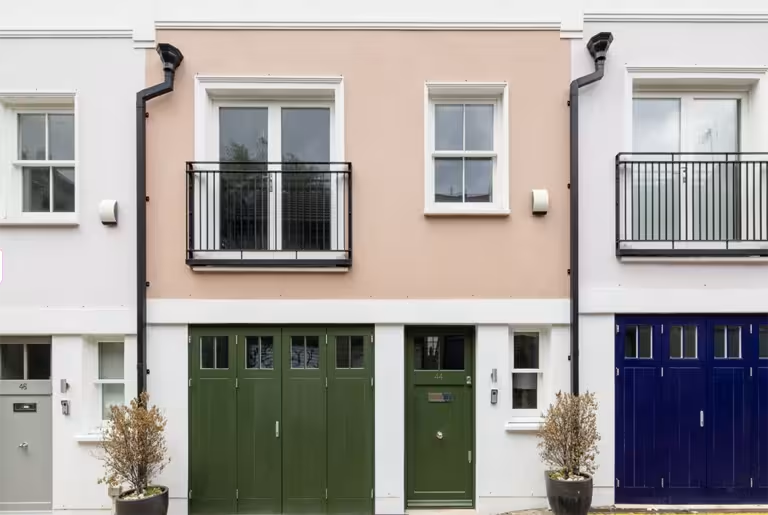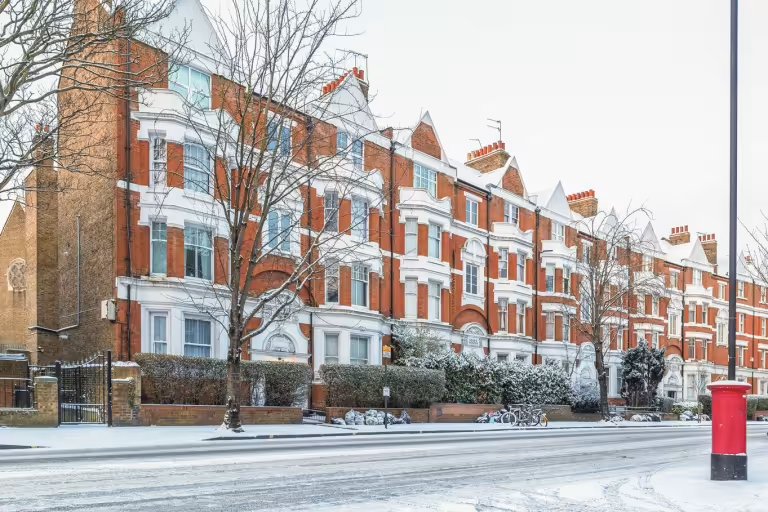Bank Rate holds at 5.25%, so when will rates drop?
The Bank Rate has remained unchanged for the fourth time in a row since it was raised from 5% to 5.25% in August 2023. Rate cuts aren’t expected until later in the year but mortgage costs have still been falling.
Why has the Bank Rate stayed the same?
The Bank of England monetary policy committee voted by a majority of 6-3 to keep the Bank Rate unchanged this month, with two members voting to increase it by 0.25% and one to cut it by 0.25%.
Although energy prices have fallen, wage growth has eased and the prices of goods and services have been rising more slowly, there’s still a risk that overall inflation will increase again.
The conflict in the Middle East and the attacks on container ships in the Red Sea are two of the factors that could see prices rising faster again.
The committee forecasts that inflation will temporarily fall to its target of 2% in the second quarter of 2024 but that it will increase again over the rest of the year.
It then thinks it will be 2.3% in two years’ time and 1.9% in three. Because of this, there are no rate cuts for now, despite little economic growth.
The Bank of England is giving nothing away about how long it thinks rates should stay the same but experts are predicting that there could be a cut in May or June.
What’s happening to mortgage rates?
While borrowers on variable rates will be disappointed that the cost of their mortgages won’t be going down this month, lenders have been cutting the rates of new mortgage deals over the last six months.
This is good news for first-time buyers but anyone remortgaging is still likely to experience a shock increase in their mortgage repayments.
Mortgage costs – whether you’re taking out a new deal or reverting to your lender’s standard variable rate – remain much higher than they were two or five years ago, when most borrowers would have taken out their current deals.
How have higher mortgage costs affected house prices?
Higher mortgage rates led to fewer property purchases and less mortgage lending in 2023, according to industry body UK Finance. Despite this drop in demand, house prices didn’t follow for the majority of UK homeowners.
According to our latest data, more than half (56%) of homeowners saw the value of their homes stay the same or increase by at least 1% in 2023.
A quarter of homes increased in value by between 1% and 5% while a 10th increased by a sizeable 5% or more.
The average value increase was £7,800. Percentage price rises were larger in more affordable areas of the country, with the biggest increases in the North West and Scotland.
This is dramatically different to 2022, though, when 96% of homes saw their value staying the same or going up and the average increase was £19,700 where it did rise.
What’s the outlook for the mortgage market?
While mortgage costs have been going down, mortgage rates will continue to be relatively high compared to two or more years ago. Rate cuts are on the horizon, though, which will be welcome news for first-time buyers and homeowners alike.
Our Executive Director of Research, Richard Donnell, says: 'The debate about the timing and scale of base rate cuts is important for the mortgage rate outlook.
'The peak in base rates last year led financial markets to bet on lower rates in 2024 and into 2025, which have shaved almost 1% off fixed rate mortgages over the last 2 months.
'There is a sense these cuts to rates are close to bottoming out for now and unlikely to move any lower.
'Inflation is down but not out and central banks want to get it under control before cutting base rates.
'It looks likely mortgage rates will remain in the 4.5% to 5% range, which is still cheap by long run standards.
'Those looking to move or refinance should chat to a broker and seek advice about the rates available and the best strategy for them.'
Key takeaways
- The Bank Rate remained at 5.25% today, despite hopes it would come down
- Inflation has fallen significantly over the past year but it's still above the Bank of England’s target of 2%. It stood at 4% in December 2023, unexpectedly rising slightly from November’s figure of 3.9%
- World events are among the factors that could push inflation up again in the second half of this year
- But experts are predicting that there could be a cut in May or June
The home value winners and losers this year
Where did homeowners gain value in the last year? Do you fall into the not-to-lucky group who lost more than 5%? Let’s find out.
Just over a year ago, all the talk was around house prices dropping by up to 10% in 2023.
But things don’t seem quite so bad in hindsight.
And a huge 77% of home values remained within the +/-5% range, highlighting the more stable nature of house prices since stricter mortgage restrictions were introduced in 2015.
Although there are some winners: 1 in 10 UK homeowners gained 5%+ in value, gaining £17,200 on average.
And some losers: just over 13% of homes dropped more than 5% in value, each losing an average of £13,200
| Lost 5% or more in value | Value remained within +/-5% | Gained 5% or more | |
|---|---|---|---|
| Percentage of UK homes | 13% | 77% | 10% |
| Number of UK homes | 3.7 million | 23.1 million | 3.1 million |
January 2024
The winners: where the most homes gained 5%+ in value
| Local authority area, region | Percentage of homes that gained 5%+ in value |
|---|---|
| Rossendale, North West | 44.2% |
| Blackburn with Darwen, North West | 34.5% |
| Telford and Wrekin, West Midlands | 32.6% |
| Merthyr Tydfil, Wales | 32.3% |
| Burnley, North West | 32.3% |
| Bolton, North West | 31.1% |
| Inverclyde, Scotland | 30.0% |
| Glasgow, Scotland | 29.7% |
| Carlisle, North West | 28.9% |
| Knowsley, North West | 27.9% |
Zoopla, January 2024
A lucky 1 in 10 homeowners have seen gains of more than 5% in 2023. That’s 3 million of you across the UK who have gained £17,200 on average.
This year’s winners are largely based in the North West, where half a million homes (17%) gained more than 5% in value. In this region, the average value increase was a tidy £13,200.
An impressive 44% of homeowners in the borough of Rossendale saw a 5% jump in value this year, where reputable schools, stunning scenery and good commuter links are pushing values up.
Elsewhere in the North West, more than 30% of homeowners gained 5% in value in Blackburn, Burnley and Bolton. These up-and-coming commuter towns are affordable and increasingly popular alternatives to Manchester.
Beautiful Inverclyde on Scotland’s west coast and the buzzing city of Glasgow also make our winners list, with 30% of homeowners gaining 5%+ this year - compared to 16% across Scotland as a whole.
The charming Telford and Wrekin area in the West Midlands and Merthyr Tydfil near the Welsh valleys are also top 10 winners this year, with 32% of homeowners gaining 5%+.
The losers: where the most homes lost 5%+ in value
| Local authority area, region | Percentage of homes that lost 5%+ in value |
|---|---|
| Dover, South East | 52.4% |
| Hastings, South East | 50.7% |
| Aberdeen, Scotland | 45.1% |
| Canterbury, South East | 43.4% |
| Thanet, South East | 40.9% |
| Rother, South East | 38.6% |
| Folkestone & Hythe, South East | 35.8% |
| Tendring, East of England | 35.3% |
| Moray, Scotland | 32.1% |
| South Holland, East Midlands | 31.5% |
Zoopla, January 2024
While home values generally fared better than expected last year, there’s no denying that some places lost out - with home values falling by 5%+ over 2023.
The South East was the worst hit, with 18% of homeowners seeing their home’s value drop by 5%+. Of these, the average loss was £13,200 over the year.
These falls are clustered around the Kent and East Sussex coasts: half of all homes in both Dover and Hastings lost 5%+ in value, along with more than 35% of homes in Canterbury, Thanet, Rother, and Folkestone and Hythe.
The East of England saw 18% of properties lose value, although by a lesser average of £11,500. The proportion of homes losing value jumps to 35% in Tendring on the Essex coast, while it was above 27% in both Colchester and Great Yarmouth.
Rural and coastal areas within commuting distance of larger cities saw a large flow of buyers during the Covid-19 pandemic. Home values in these areas are adjusting back now that demand has cooled.
Who will win and lose in 2024?
We think this year will serve up more of the same for homeowners in the UK.
We’re expecting an average fall of around 2% across the country, although - like 2023 - this will differ depending on where you live and what sort of home you own.
How do we work out home values?
We only use data from regulated sources to create our home estimates. These sources include:
-
Data from HM Land Registry and Registers of Scotland
-
Official survey records from accredited surveyors
-
Energy Performance Certificates
We combine this data with live property listings in your area to take the latest local market trends into account.
Once we’ve created estimates for around 30 million homes in the UK, we can analyse the data as a whole and bring you reports like this.
But we don't claim to know everything. We provide confidence ratings to let you know if our data sources haven't updated or we don't have enough info.
And that's why we always recommend you get an estate agent valuation for the most accurate picture of what your home is worth.
Key takeaways
- 1 in 10 UK homeowners gained 5%+ in value in 2023
- The largest proportion of homeowners (77%) saw no significant change to their home’s value in 2023, contradicting predictions of major price falls
- But there are some losers - 13% saw their home’s value fall by 5%+ in the last year
3 in 5 homes rise in value over 2023
At the beginning of 2023, commentators predicted home values would plummet by as much as 10% over the course of the year. Here’s what actually happened.
In 2023, the press was filled with gloom and doom predictions of homes plummeting in value by as much as 10%.
However, our data reveals that in reality, more than half of UK homeowners (56%) saw their home values stay the same or increase by at least 1% over the course of the year.
Senior Property Researcher, Izabella Lubowiecka, says: ‘Where values went up, the average increase seen was £7,800. And 1 in 10 (or 3 million) UK homeowners even registered gains of more than 5% (or £17,200).’
It is a different picture to what happened the year before in 2022, when 96% of homes either held their value or saw an increase. Back then, the average value hike was £19,700.
However, we can clearly see that most homeowners didn’t see the hefty value falls that some initially predicted.
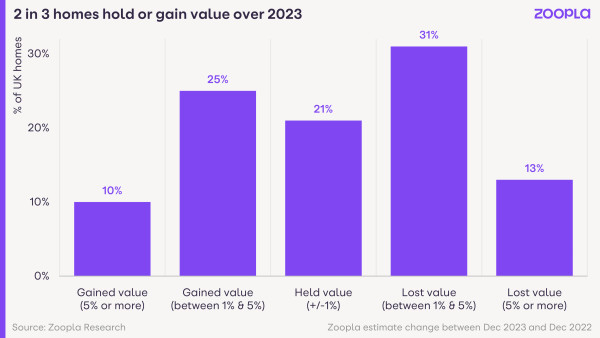
Where did homes rise in value in 2023?
‘There is a clear north-south divide in the fortunes of homeowners during 2023,’ says Lubowiecka.
‘Areas with lower house prices were cushioned from the impact of higher mortgage rates, helping to support activity and sustain house prices in these regions.
‘So in the more affordable parts of the country, such as the north, home values increased.’
In fact, the North West led the way in value gains, with the highest proportion of homes registering value increases of 5% or more (£13,200 on average).
Here, terraced homes proved to be the hottest properties, with 19% of terraces rising by 5%+.
It was hotly followed by Scotland, where 16% of homes (400,000), increased in value by 5%.
Here, apartments proved to be the highest risers, with 19% registering a value increase of 5%+.
The North East and Yorkshire and the Humber take joint third place, with 1 in 7 homes going up in value by 5%+.
Flats were the winners in the North East, with 25% rising by 5%+ in value.
Meanwhile, in Yorkshire and the Humber, terraced homes came up trumps, with 16% rising by 5%+.
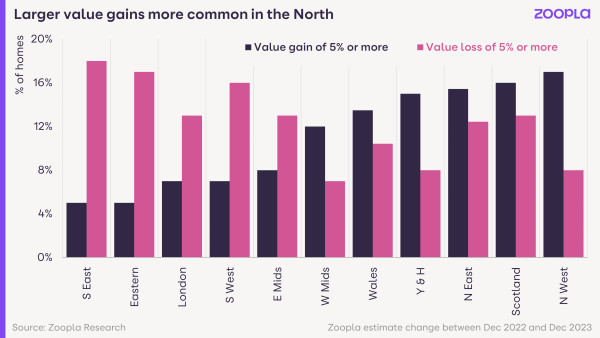
Which types of homes held their value in 2023?
In 2023, the nation’s favourite property types: semi-detached homes and terraces, proved to be the best at holding their value.
‘Homes seen as good value for money continued to attract buyer interest, leading to stronger price performance,’ says Lubowiecka.
‘That said, the larger value gains of 5%+ were equally spread across different property types and enjoyed by 1 in every 10 UK properties.’
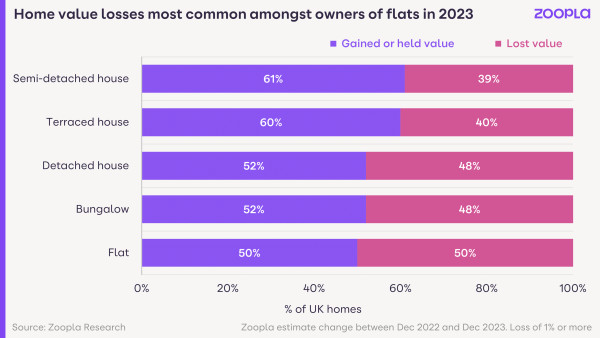
Where did home values fall in 2023?
While home values did better than expected, not all homeowners saw their homes increase in value in 2023.
44% of UK homes fell in value by at least 1% over the course of the year. Within that 44%, one third of homes lost 5%+ of their value from 2022.
Homeowners in the South, where house prices are less affordable, were most likely to see the falls.
Some 3 in 5 (or 4 million) homeowners in the East and the South East of England saw a value decrease of 1% or more.
And just over a million of these saw decreases of 5% or more.
‘In the East of England, the average loss was £11,500, while in the South East, it was £13,200,’ says Lubowiecka.
‘The coastal areas of Kent and East Sussex suffered the most in terms of value losses, with half of homeowners in Dover and Hastings experiencing value falls of 5% or more.’
During the pandemic, these rural and coastal areas within commuting distance of larger cities saw a large influx of buyers, boosting house price growth.
But now demand is starting to wane, leading to larger value falls here.
Which types of homes lost the most value in 2023?
Detached houses were most likely to lose value in the East of England (23%), while in the South East, apartments bore the brunt of the losses (25%).
Across the UK as a whole, value drops were more common for detached houses and bungalows, which are less common and often priced at a premium. 48% of these property types lost value in the last year.
Flats also suffered in 2023, despite some pick-up in buyer interest. Our data shows that exactly half of UK flats lost some value last year.
Larger flats fared better than smaller flats, with 52% of 3-bed flats holding or increasing in value. But in contrast, only 46% of 1-bed flats enjoyed the same benefits.
Why we didn’t see house prices plummet in 2023
New mortgage regulations introduced in 2015 helped to prevent homes from being ‘over-valued’, which can lead to property market crashes.
When agreeing to offer mortgages, lenders had to ensure their borrowers could still repay those mortgages at higher interest rates when they took out the loans.
So, if your mortgage rate was say, 2%, you had to prove you could still afford to repay it if it rose to 5%.
That, in turn, meant borrowers wouldn’t be forced to sell their homes if mortgage rates increased, because they had already proven they could meet those higher monthly payments.
Lots of forced sales negatively affect property values, so these regulations helped to protect house prices from a major downturn.
Will home values rise or fall in 2024?
‘Zoopla predicts modest house price falls of 2% in 2024 across the UK,’ says Lubowiecka.
‘This signals a repetition of the last year in terms of pricing as well as key themes influencing the market.
‘How this is going to impact your home value depends on where you are in the country and what property type you own. But we expect those who saw home value growth in 2023 to see similar increases in 2024.’
Higher mortgage rates will continue to limit many peoples’ buying power, and this impact will be most felt in the high-value regions in the South.
‘We anticipate further value drops in the south, especially in areas where values shot up during the pandemic.
‘Flats and detached homes here are most likely to register further value falls, so if you’re planning to sell a home like this in 2024, it’s important to set your price at a realistic level right from the start,’ advises Lubowiecka.
Meanwhile, popular property types such as terraces or 3-bed houses that offer good value for money are likely to hold or increase in value.
Thinking of selling? It’s always a good idea to speak to a local agent to get a valuation for your home.
Estate agents will be on top of all of the local market trends in your area, while taking into account your property’s unique characteristics and all of the improvements you’ve made to it to set the best possible price for a sale.
How we calculate our home values
Monthly estimates for every home in the UK, to show homeowners how much their home is worth.
Our data source, Hometrack's market-leading Automated Valuation Model, is reliably used by mortgage lenders across the UK to assess a home’s value.
And while not as conclusive as an agent valuation, which takes in all of the recent work you might have done to your property, our estimates provide a good initial indication of your home’s worth to help you unlock your next move.
How current estimates differ from sold house price data
Every month, we and many other organisations publish a house price index.
House price indices are a useful guide to the overall direction of travel in national house prices.
But homeowners really want to understand how the value of their own home is moving over time, which could be different to what’s reported in a national index.
In 2023, most house price indices registered modest annual price falls as higher mortgage rates hit buying power.
Many places experienced price falls for the first time since the Global Financial Crisis in 2007.
But while the overall average UK house price moved lower over 2023, the nation’s 30 million homes are spread across thousands of housing markets.
And our data reveals not every home fell in value last year: 3 in every 5 homeowners can testify to that.
Key takeaways
- 3 in 5 homeowners saw their homes hold their value or rise by an average of £7,800 in 2023
- 1 in 10 saw their home’s value increase by 5% or more
- Greater gains were seen in affordable areas like the North West, whereas homes in the South were more likely to see values drop
Two-thirds of first-time buyers team up to step on the property ladder
First-time buyers accounted for more than half of all home loans in 2023 - and more than two-thirds teamed up to secure their own homes.
Almost two thirds of first-time buyers teamed up last year in a bid to get onto the housing ladder.
Against a challenging economic backdrop, 63% of first-time buyer mortgage completions in 2023 were in joint names, with two or more people. Just 37% were sole applications, according to the latest research from Halifax.
First-time buyers accounted for just over half (53%) of all home loans last year, the highest proportion since 1995.
But the overall number of buyers that stepped onto the housing ladder last year stood at 293,339 – a 21% drop compared with 2022.
The number of first-time buyers fell in all regions across the UK in 2023, with the greatest drops in East Anglia and the south east.
What was the average deposit paid by first-time buyers in 2023?
Halifax said it was ‘unsurprising’ that the bulk of first-time buyer mortgage applications were joint, given the increase in deposits over the last decade.
First-time buyers forked out an average deposit of £53,414 last year, around 19% of the purchase price. That’s £9,057 (15%) less than in 2022 but £21,000 (67%) more than 10 years ago.
And even though the typical salary is higher than 10 years ago, first-time buyers have to save more than a year’s average pay for a deposit large enough to buy a first home, according to the lender.
Terraced homes most popular among first-time buyers
In a glimmer of hope for aspiring homeowners, the average price tag of a home for a first-time buyer fell 5% from its peak in 2022 to £288,136.
But house prices for first-time buyers remain over £132,000 (86%) more expensive than a decade ago.
Halifax’s research also revealed that terraced homes were the most sought-after type of property for first-time buyers in 2023, making up 30% of all first-time buyer mortgages.
But their popularity has faded over the last decade, with the number of first-time buyers snapping up a terraced home dropping by 7% compared with 2013.
Flats, on the other hand, have risen in popularity. The number of first-time buyers purchasing a flat over the last 10 years has climbed by 6%, increasing in every region and nation in the UK.
Where are the most affordable places to step onto the housing ladder?
First-time buyers should look to Scotland to boost their chances of homeownership. Many of the most affordable places to buy a first home are in Scotland, said the lender.
Inverclyde was crowned the most affordable area last year, where properties were around 2.6 times the average salary (£41,598).
At the other end of the spectrum, London was home to some of the least affordable places to get onto the housing ladder. Properties in Islington, north London, were a whopping 10.6 times the average salary (£57,548).
To put these figures into wider context, average property values for first-time buyers are around 6.7 times the average UK salary (£43,257), according to Halifax.
Kim Kinnaird, director, Halifax Mortgages said: ‘Following a record year in 2021, unsurprisingly in view of the wider economic environment, the number of first-time buyers joining the property market fell again in 2023 to around 293,000.
‘Despite this drop, new buyers made up over half of all home loans. However, to get a foot on the ladder most people are now buying for the first time in joint names.
‘The overall fall in house prices we saw in 2023 will go some way to helping people get on the ladder for the first time – but these buyers are still dependent on a steady supply of properties in their price range, while they are faced with the continued pressure of saving for a deposit, when rent and living costs are high.'
Key takeaways
- Almost two thirds of first-time buyers teamed up to buy a home last year, with 63% of mortgage completions in joint names, says Halifax
- The average deposit paid was £53,414, around 19% of the purchase price
- Inverclyde in Scotland has been crowned the most affordable place in the UK to step onto the housing ladder, while Islington in London is the least
‘First-time buyers have been hit especially hard by rising mortgage rates. The sub-4% deals we increasingly hear about are typically for those with equity levels of 40% or more,’ explained Tom Bill, head of UK residential research at Knight Frank.
‘The government is likely to offer first-time buyers more financial support ahead of the election this year given that housing is a key political battleground and based on the belief that homeowners are more likely to vote Conservative.’
Will house prices rise in 2024?
If you’re planning to buy or sell a home in 2024, what should you do? Our Executive Director of Research, Richard Donnell, shares his UK house prices forecast.
The first weeks of January have been full of reports about improving conditions in the housing sales market. Some are now projecting that UK house prices might even rise in 2024.
There has been a bounce-back in activity, which has followed the usual seasonal pattern. This is positive news but home buyers and sellers shouldn’t get too carried away with the hype.
Our data shows we are still locked in a buyers market, so it’s unlikely that we will see prices rise in 2024 at a national level. But at the same time, they haven’t fallen much over the last 12 months, despite mortgage rates more than trebling since 2021.
We believe that house prices still need to adjust to higher mortgage rates, even though these are now falling and appear to be on track to get into the 4%-4.5% range later this year.
This means sellers have to remain realistic on what someone will pay for their home and seek advice from an estate agent on how best to get their home ready to sell.
Return of pent-up demand after weak 2023
Demand for homes has certainly jumped out of the blocks in the first weeks of January as pent-up demand from 2023 returns to the market, encouraged by falling mortgage rates.
More than 75% of all homes currently for sale are featured on Zoopla and we can see that buyer demand is 10-15% higher than the pre-pandemic years of 2017-2019 - and also higher than at the start of 2023.
However, demand levels are still more than a third lower than they were at the start of the hotter pandemic years of 2020-2022.
Plenty of choice for buyers will keep price rises in check
While we have a return of buyers into the housing market, there are also many more homes for sale. This greater choice of homes available is likely to limit the scope for price rises in 2024.
One feature of the pandemic years was a chronic shortage of homes for sale, which drove faster price rises. The low point was just 14 homes per estate agent in late 2022.
Supply is now more than double these lows and back up to an average of 30 homes for sale per agent, closer to the pre-pandemic average.
There are also more larger, 4+ bed family homes for sale, as some sellers re-list homes that might have been on the market in 2023 and struggled to attract interest.
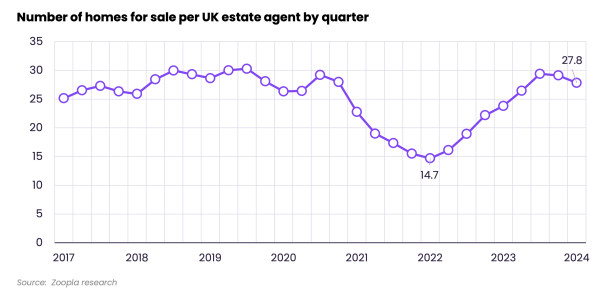
More supply and weaker demand led to a drawn out re-pricing of homes listed for sale over 2023, as sellers adjusted asking prices lower in order to attract demand.
This accelerated in the second half of 2023 as higher mortgage rates hit buying power.
Asking price reductions for homes listed for sale have picked up again in January 2024, which is a sign that house prices are still adjusting to higher borrowing costs.
They aren’t as high as this time last year but are higher than those seen in previous years, as sellers speak to their agents about how to pitch their home at the right price level to attract renewed interest.
Half of owners with a mortgage still need to move onto higher mortgage rates
Buyers remain price sensitive and many with mortgages are still yet to remortgage onto higher rates.
The Bank of England estimates that around 55% of mortgage accounts (around 5 million), have remortgaged since rates started to rise in late 2021.
Higher mortgage rates are expected to affect around a further 5 million households by 2026.
For the typical owner-occupier mortgagor rolling off a fixed rate between 2023 Q2 and the end of 2026, their monthly mortgage repayments are projected to increase by around £240, or around 39%.
The good news is that the more mortgage rates decline, the smaller the jump in repayments.
However, for those looking to buy a home and trade-up for more space or a nicer area, this means spending more and taking on a larger loan, adding to monthly mortgage payments.
With inflation not falling as fast as economists expected, the decline in mortgage rates is set to moderate, despite intense competition between banks.
The cost of mortgages is set to keep buyers focused on value for money, even as mortgage rates fall, keeping prices in check.
It's still a buyers market and sellers need to price carefully
The average UK seller is having to accept offers below the asking price and the typical discount from the asking price to the agreed sale price is around 5%.
This is slightly below the long run average and well down on the hot market conditions seen over the pandemic years.
This proportion is not growing, which means larger price falls are unlikely. But it shows sellers will need to price carefully to ensure they attract demand.
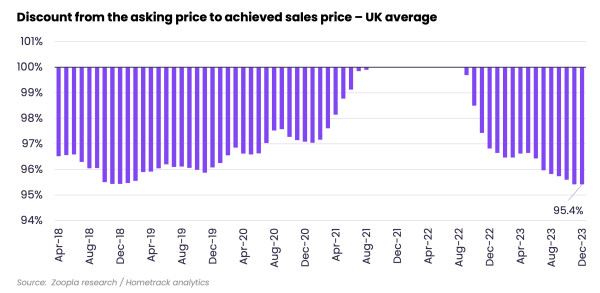
The proportion of sellers achieving their asking prices varies across the UK, with slightly larger discounts happening in southern England.
Here, prices are higher than the national average and for that reason, the impact of higher mortgage rates on pricing levels has been greater than in other regions.
How should sellers and buyers respond to the positive start to 2024?
The positive news at the start of 2024 should boost market confidence and encourage more buyers and sellers into the market.
But it’s important sellers don’t get too carried away and shift expectations on what their home is worth in 2024 versus 2023.
It all depends on what you are looking to sell and how closely this matches to who is in the market looking to buy in your area and price range.
For example, we expect first time buyers to remain a very important group in 2024. However, this group is not focused on buying larger homes, where there is more supply.
Larger homes will mainly appeal to upsizers, who are likely to need bigger borrowings to buy at higher mortgage rates than 2-3 years ago.
We don’t expect house prices to suddenly start rising in 2024, but more demand and sensible pricing of homes for sale is likely to boost housing sales and overall levels of activity.
Key takeaways
- We are still locked in a buyers market, so it’s unlikely we'll see prices rise in 2024 at a national level
- House price falls were modest in 2023, despite mortgage rates more than trebling since 2021
- But buyers remain price sensitive and 45% of those with mortgages are yet to remortgage onto higher rates
- Inflation appears sticky, meaning there is only so far mortgage rates are likely to fall
- The average UK seller is having to accept offers and is getting around 95% of the asking price, so sellers must remain realistic on pricing
Renters paying an extra month's rent per year after latest rises
Rents jumped 9% in the last year, adding £1,200 - a month’s worth of rent - to the average annual bill.
2023 was another tough year for renters, with average rents for new lets reaching £1,200 in November - 9% higher than a year ago.
It means renters have seen an extra £1,200 - or a month’s worth of rent - added to their annual bill.
The table shows how much rents for new lets have increased across the UK in the last year.
| Region | Annual rental increase (%) | Annual rental increase (£) | Average monthly rent |
|---|---|---|---|
| Scotland | 12.1% | £84 | £780 |
| North West | 10.8% | £81 | £831 |
| Wales | 10.1% | £78 | £852 |
| North East | 9.7% | £60 | £672 |
| East Midlands | 9.7% | £75 | £846 |
| East of England | 9.5% | £99 | £1,145 |
| South East | 9.3% | £110 | £1,294 |
| West Midlands | 8.8% | £72 | £883 |
| South West | 8.6% | £83 | £1,061 |
| London | 8.0% | £157 | £2,128 |
| Yorkshire | 7.7% | £56 | £782 |
| Northern Ireland | 4.9% | £35 | £750 |
Zoopla Rental Index, data to November 2023 published in January 2024
Rental inflation in Scotland boosted by rent controls
In September 2022, the Scottish Parliament introduced a rent cap of 3% on annual rises to existing tenancies.
While intended to reduce cost-of-living pressures for renters, it means landlords are now going higher at the start of a tenancy to cover their costs and the limited increases during the contract.
In fact, Scotland has registered the highest level of annual rental inflation in the UK at +12.1%. The average monthly rent in Scotland stands at £780, £84 more than a year ago.
This is a slower rate of growth than the highs of +13.7% back in February 2023, but we still expect Scotland to see faster rental growth than anywhere else in the UK in 2024.
In turn, Scottish cities continue to register some of the largest rent increases in the country. Over the last 12 months, the average monthly rent in Edinburgh increased by £150 and in Glasgow by £100.
Rental inflation is much less dramatic in rural parts of Scotland, with Ayrshire, Moray and the Highlands all recording growth below +7%.
London leads the slowdown in rental growth
Rental inflation has slowed down in southern cities in the last 12 months, giving some relief to renters in the expensive South of England.
The largest moderation is in London, where rental inflation has dropped from +15.9% a year ago to +8.1% today.
Rental growth has slowed the most in Inner London boroughs. A year ago, we were seeing rises of +14.9% in Hammersmith and Fulham and up to +21.1% in Tower Hamlets. Today, no inner borough is seeing growth of more than +9.5%.
However, outer boroughs are a different story, seeing some of the highest rent increases in England right now. Rents have risen by more than +13.5% in boroughs like Hillingdon, Redbridge and Barking and Dagenham.
The second and third largest slowdowns are recorded in Bristol and Newport, where rental inflation has fallen to +7.9% and +8.8% respectively.
These reductions suggest landlords are becoming more realistic in pricing their rentals and may be taking cost-of-living struggles into consideration when setting new rates, which tend to be exacerbated for those in the rental market.
What are renters doing to minimise the impact of higher rents?
Some renters have escaped the steepest rises by staying in their existing homes.
Year-on-year rises for established tenancies rose at the slower rate of 6.2% according to the Index of Rental Prices from the Office for National Statistics.
When renters move and are faced with higher rents and a limited supply of homes on the market, they're more commonly considering renting smaller homes, moving to cheaper areas or house-sharing to reduce costs.
House-sharing reduces the cost of housing per person but it comes at the personal expense of privacy and space. Data from the Resolution Foundation found private renters have experienced a 16% reduction in floor space per person over the last 20 years.
What’s next for the rental market?
We believe that the rental market is now past peak rental growth after starting to cool in the final months of 2023.
We expect a further slowdown in rental growth in 2024 as worsening affordability keeps demand in check and supply improves slowly. There are already signs asking rents have overshot in some markets that are showing resistance to higher rents.
Slower increases will be welcome news to renters who have often faced steep hikes in the last two years.
Key takeaways
- A 9% rise in average monthly rent has added £1,200 to the average annual bill since this time last year
- Renters are now paying £1,200 per month on average, ranging from £672 in the North East to £2,128 in London
- Rental growth slowing to single digits is a sign we're past peak growth after nearly two years of 10%+ increases
- Scotland continues to register the highest rental growth despite rent controls
- London and the South of England are seeing rent growth slow the most as rents hit an affordability ceiling
- We expect a further slowdown in rental growth in 2024 as worsening affordability keeps demand in check
Buyers return amid falling mortgage rates
The first full week back after the new year has seen buyer interest jump out of the blocks faster than last year as mortgage rates drop. Get the latest with Richard Donnell.
The start of 2024 has seen a slew of more positive news on the housing market.
Over the last month, we’ve seen further signs that house price falls are slowing, alongside a further drop in average mortgage rates for new borrowers with some very competitive deals at 60% loan to value.
This reflects what we reported in our most recent house price index: a 17% increase in new sales agreed as buyers sought to lock down new deals at the end of 2023.
This improvement in market activity looks to be rolling over into the start of 2024, driven by improving mortgage rates.
London and South East lead fast start to 2024
The first full week back after the new year has seen buyer interest jump out of the blocks faster than last year and the pre-pandemic period in 2019.
It’s early days but our data shows demand at the end of the first week of January was more than 10% ahead of the same period a year ago.
Demand has jumped most in London and the South East, where house price gains over recent years have been much lower than the rest of the UK, which has helped improve housing affordability.
Modest house price falls over 2023
Our UK house price index shows that prices are 1.1% lower than a year ago, with signs that the scale of price falls is slowing.
Sales volumes are now starting to improve with buyers returning to the market.
While the Zoopla house price index has recorded a modest fall in UK house prices over the last 12 months, the profile of price changes varies widely across the UK.
The largest price falls are up to 4% and concentrated across southern England in markets which saw the greatest demand over the pandemic, including those in the East of England and Kent.
Prices are also falling in areas where there has been strong demand for second homes, such as North Wales and the South West.
In contrast, house price inflation remains positive in many areas across northern England and Scotland. The rate of price gains has slowed quickly from double digit growth at the end of 2022 to close to 0% now but prices aren’t falling everywhere.
The greatest downward pressure on prices has been in southern England, where higher house prices mean a greater impact from higher mortgage rates.
This is where sellers are having to accept larger discounts to the asking price to achieve a sale, averaging around 6%.
While house prices are highest in London, they aren’t leading the fall. That's because the London market has lagged behind the rest of the country in terms of price growth over the last 6 years, making homes slightly less expensive and more accessible to buyers.
Annual house price inflation by postcode area November 2023
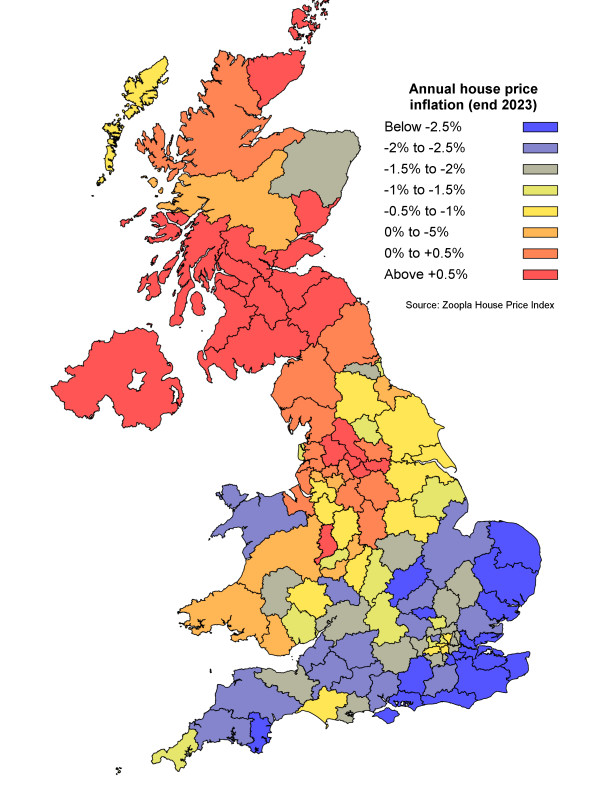
Nearly all homeowners are sitting on gains vs the start of the pandemic
House price falls have been modest, despite higher mortgage rates, because of the mortgage regulations introduced in 2015 by the Bank of England.
These regulations stopped the development of a bubble in house prices and are a key reason why price falls have been small over 2023.
The net result is that most areas have house prices still well above the levels they were before the pandemic hit the market, which created a boom in demand for housing.
The average UK home is now worth 18% (or £41,000) more than it was at the start of the pandemic in March 2020.
The map below shows the difference in house prices between March 2020 and November 2023.
It shows that the Northern regions, Wales and the South West are where house prices pushed highest during the pandemic - and that average prices in these regions are still over 24% higher than their pre pandemic levels.
Price gains have been more modest in and around London, where affordability pressures and mortgage regulations have limited the scope for price gains.
So for those looking to sell and move in 2024, the vast majority of homeowners are sitting on price gains compared to the pre-pandemic period.
It’s a much better position than many people predicted we would be in a year ago, although not us however.
House price growth since the start of the pandemic March 2020

What does this mean for buyers and sellers?
We certainly expect news of lower mortgage rates to boost buyer demand and bring more interest into the market over the coming months.
Buyers understand that there is more room to negotiate on pricing with sellers but many will also still need to sell a home to unlock their next move.
Sellers will need to remain realistic over the value they expect to achieve from their property and be prepared to negotiate on price.
We saw a steady reduction in asking prices over 2023, as sellers worked with their estate agents to get the pricing right to attract demand and increase the chances of securing a sale.
Much depends on the type of property you're selling and its location, so it’s essential to speak to your local agent to get a view of demand for a home like yours in the current market.
Key takeaways
- The number of buyers out home hunting has shot up 10% compared to this time last year
- House price falls are starting to slow as sales agreed rise by 17%
- The average UK home is worth 18% (or £41,000) more than it was in March 2020
- Mortgage rates drop further with some very competitive rates for borrowers with a 60% LTV
House Price Index: December 2023
House price inflation running at -1.1% as market sentiment improves with demand up and more sales agreed. Get the latest in our December House Price Index with Richard Donnell.
Sales hold up in Q4 2023, providing support for prices
The final weeks of 2023 have recorded above average levels of new sales, 17% higher than a year ago.
Market sentiment is improving due to rising incomes and an initial decline in mortgage rates. Demand is also 19% higher than a year ago.
An increase in available supply, up a quarter on last year, is also boosting choice and supporting sales. Buyers and sellers are becoming more aligned on pricing, reducing the downward pressure on values.
Our headline UK house price index has recorded a slower pace of annual price decline at -1.1% in November 2023, down from +7.2% a year ago.
And price falls have now moderated across all regions and countries of the UK.
House price indices can show varied trends when the market turns
UK house price indices track well over time, but they tend to separate at key moments as the volume and mix of sales changes.
The Zoopla house price index is based on the largest dataset of any UK house price index.
It has performed inline with the ONS house price index, with both series including cash and mortgaged sales.
In 2023, cash purchases look set to account for a third of all sales and are therefore an important source of pricing evidence.
The average price of a cash purchase is 10% lower than the average mortgage funded sale. This makes cash purchases slightly more affordable, especially since there is no mortgage process or valuation required to enable a sale.
Mortgaged sales are on track to be 30% lower over 2023 as higher mortgage rates hit demand. Because of this, mortgage lenders’ house price indices responded quickly to weaker demand, recording steeper price falls over 2022 Q4 and 2023 H1.
However, the annual growth rate in house prices recorded by lenders has improved in recent months as market activity and pricing stabilises, bringing it back towards the Zoopla/ONS series.
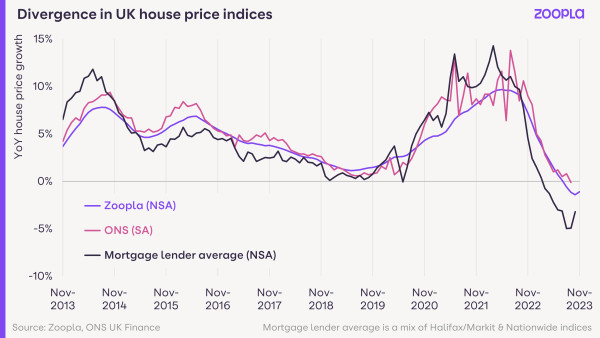
Why haven’t house prices fallen more in 2023?
History suggests that mortgage rates rising from 2% to over 5% would have led to larger price falls than what has been recorded over 2023.
There are several reasons why prices have defied the predictions of larger falls:
1. The strength of the labour market has been an important factor along with high growth in average earnings.
2. Lenders have also pursued forbearance policies to support households struggling with repayments, which has limited the number of forced sellers.
3. And perhaps the most important factor of all: the introduction of tougher mortgage affordability testing for new borrowers since 2015.
These regulations were designed to stop households taking on excessive debts at a time of low mortgage rates.
They have stopped a major housing overvaluation and built resilience for many households to manage the transition to higher mortgage rates.
While mortgage rates got as low as 1.3% in late 2021, all new mortgage borrowers had to prove to their bank that they could afford a 6-7% stressed mortgage rate to get the loan (see chart below).
Banks were also limited to 15% of new business at high loan to income ratios over 4.5x.
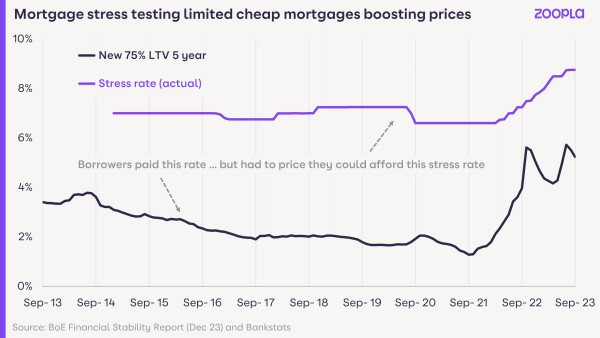
These regulations have effectively capped buying power for home buyers.
They require the borrower to have a higher income to buy and put down a larger deposit, which is especially true in higher value housing markets.
ONS data shows that first-time buyers in London put down an average deposit of £145,000 in 2022, compared to £26,000 for those buying in the North East.
Today, lenders are stress testing new borrowers at close to 9% despite mortgage rates starting to fall.
This regulatory constraint on buying power is one reason we believe house prices are unlikely to rise in 2024, even as base rates start to fall later in the year.
First-time buyers to remain largest buyer group in 2024
Despite the affordability challenges facing first-time buyers, they will be the largest group of would-be buyers in the next 2 years.
Our latest consumer survey of home moving intentions found that 40% of people looking to buy a home in the next 2 years are first-time buyers.
The rapid growth in rents continues to motivate this group - average rents have risen faster than average mortgage repayments over the last 3 years - despite the need for higher deposit levels.
Upsizers account for a third of would-be buyers in the next 2 years, who will typically be buying a larger home that will require a larger mortgage.
This group has been biding their time in 2023, waiting for the outlook on the economy and mortgage rates to become clearer. The trajectory for mortgage rates and getting better value for money will be key considerations for upsizers in 2024.
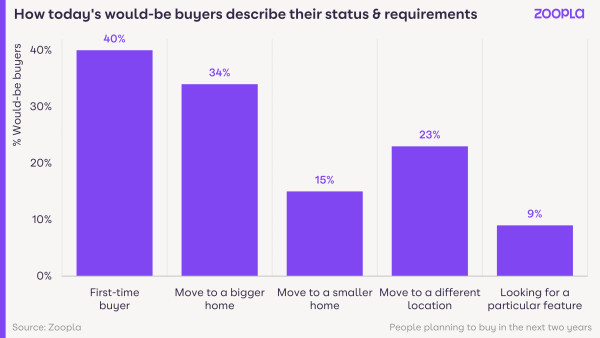
Buyers look further afield for better value
Almost a quarter of would-be home movers say they are looking to move to a different location.
A high proportion of home moves tend to be limited to within local areas - the average distance buyers are looking to move when searching on Zoopla is 4.3 miles.
However, in the face of higher borrowing costs and the search for value, one of the key trends for 2024 will be buyers continuing to look further afield in search of better value.
This is particularly the case in high value housing markets where upsizing is expensive.
Our data shows that almost half of would-be movers currently living in southern regions are looking to move more than 10 miles. The proportion looking longer distances in other parts of the UK is lower.
This is important for home builders and estate agents who tend to focus on demand and needs in local areas whereas there is the need to capture and nurture demand coming from further afield, especially as these buyers may well have more money to spend.
Outlook for 2024
We expect the steady momentum in new sales that has developed over the final quarter part of 2023 to continue into early 2024, with the usual seasonal rebound in demand over Q1 as pent-up demand returns to the market.
While mortgage rates are edging lower, affordability remains a key challenge for mortgage reliant households who are making home moving decisions.
The impact of higher mortgage rates continues to feed through with half of mortgagees yet to move onto higher rates from cheaper fixed rate deals agreed before 2022.
The modest decline in house prices over the year means UK housing still looks 10-15% overvalued at the end of 2023. We expect this position to improve over 2024 as incomes rise and house prices drift 2% lower over the year. Sales volumes are expected to hold steady at 1 million sales completions over 2024.
Key takeaways
- Annual UK house price inflation running at -1.1% (compared with +7.2% in Nov-22)
- Market sentiment improving with new sales agreed running 17% higher than a year ago, demand is also 19% higher as buyer sentiment improves
- House price falls starting to moderate as sales volumes improve
- Mortgage regulations a key reason for only modest price falls in 2023 along with strong labour market and rapid earnings growth
- First-time buyers are largest group of would-be movers in next 2 years (40%) followed by upsizers (34%)
- Almost half of buyers living in southern England looking to move more than 10 miles, in search of better value for money
- House prices to fall 2% over 2024 with 1m sales
Are UK house prices falling in December 2023?
UK house prices have fallen -1.1% in the last year, bringing the average house price to £264,500. So where’s faring worst, and is anywhere escaping the price falls so far? Let’s find out what’s happening with house prices in December 2023.
The average UK house price is now £264,500. That’s £2,990 lower than a year ago and £100 lower than last month.
However, the rate of house price falls has moderated across all regions and countries of the UK. Buyers and sellers are becoming more aligned on pricing, reducing the downward pressure on values.
Our UK House Price Index has recorded a slower pace of annual price decline at -1.1% in the last year (versus +7.2% a year ago). Prices fell -1.1% in the year to November 2023, -1.4% in the year to October and -1.2% in the year to September.
Where are UK house prices falling in December 2023?
Regions
Homeowners in Southern England are seeing the biggest fall in house prices. The East of England (-2.7%), the South East (-2.4%) and the South West (-2.2%) are the worst hit, as higher mortgage rates reduce demand the most in more expensive regions.
On the other hand, property prices are now +2.1% and +1.3% higher than a year ago in Northern Ireland and Scotland respectively.
Lower average house prices here means many people can still afford to buy a home with a higher mortgage interest rate. This keeps the housing market moving and gives less need for sellers to reduce their prices.
Cities
Cities in the South of England are seeing the biggest house price falls, with Southampton (-2.8%) hit harder than any other UK city.
Fellow south coast cities Portsmouth (-2.4%) and Bournemouth (-2.1%) are among the larger price falls, along with Cambridge (-2.6%) in the East, Leicester (-2.0%) in the East Midlands and Bristol (-1.9%) in the South West.
These Southern cities enjoyed strong buyer demand and significant price growth during the pandemic. But now demand is falling and supply is growing, there is downward pressure on local property prices.
On the other hand, house prices are still rising slowly in more affordable cities in Scotland, Northern Ireland and the North of England. This includes Belfast (+3.2%), Glasgow (+1.3%), Edinburgh (+0.9%) and Newcastle (+0.5%).
Local authority areas
Parts of Kent and Norfolk are seeing the biggest house price falls in the country. Many of these popular areas saw prices rise sharply during the pandemic due to strong demand in the ‘race for space’ or lifestyle influences.
But now they’re seeing demand fall and supply grow due to higher mortgage rates, putting the negotiating power in buyers’ hands.
| Local authority area and county | Annual house price change (%) | Annual house price change (£) | Average house price |
|---|---|---|---|
| Dover, Kent | -4.5% | -£13,960 | £297,900 |
| Canterbury, Kent | -4.5% | -£15,790 | £343,800 |
| Thanet, Kent | -4.3% | -£13,180 | £293,300 |
| Broadland, Norfolk | -4.1% | -£13,460 | £318,000 |
| North Norfolk, Norfolk | -4.1% | -£13,230 | £313,100 |
| South Norfolk, Norfolk | -4.1% | -£13,640 | £322,600 |
| Breckland, Norfolk | -4.0% | -£11,510 | £273,300 |
| Great Yarmouth, Norfolk | -4.0% | -£8,060 | £193,200 |
| Norwich, Norfolk | -4.0% | -£9,480 | £226,200 |
| Waveney, Suffolk | -4.0% | -£10,120 | £241,900 |
Zoopla House Price Index, December 2023
Why are UK house prices falling?
Higher interest rates on mortgages have made it harder for people to buy a home, which reduces demand for property. At the same time, there are many more homes on the market than in recent years.
These factors together create a buyers’ market - when buyers have more choice so sellers are under pressure to price more competitively in order to sell.
However, the market is in a much better condition than this time last year, when the fall-out from the mini budget was still fresh. Buyer demand is up +19% on a year ago which is helping +17% more new sales agreed. There is also an increase in available supply, up a quarter on last year, which is boosting choice and supporting sales.
Why haven’t house prices fallen further in 2023?
History suggests that mortgage rates rising from 2% to 5%+ would have led to larger house price falls than those we’ve recorded in 2023.
But there are several reasons to explain the more modest falls.
The strength of the labour market and high growth in average earnings are important factors.
Lenders’ forbearance policies are supporting households struggling with repayments, which has limited the number of forced sellers.
Perhaps most important is the tougher mortgage affordability testing for new borrowers since 2015. New regulations were designed to stop households taking on excessive debt and artificially inflating house prices.
This has prevented a major housing overvaluation and made sure that most households can manage the transition to higher mortgage rates.
While mortgage rates dropped as low as 1.3% in late 2021, new mortgage borrowers had to prove they could afford a 6% to 7% rate. At the same time, banks were only allowed to lend 15% of new customers more than 4.5 times a salary.
These regulations mean mortgage borrowers must have a higher income and put down a larger deposit. The higher the house prices, the more they need.
The chart shows the rate at which lenders have stress-tested over the last 10 years versus the mortgage rate borrowers have paid.
Will house prices keep falling in 2024?
Yes, our data suggests that house prices will keep falling slowly next year.
After three years of strong price growth up until 2022, higher mortgage rates are resetting the price people can afford to buy at.
Despite a modest decline in house prices over 2023, UK housing still looks 10-15% overvalued at the end of the year. We expect this position to improve during 2024 as incomes rise and house prices drift 2% lower. Sales volumes are expected to hold steady at 1 million sales completions over 2024.
Lenders are stress-testing new borrowers at close to 9%, despite actual mortgage rates starting to fall. This regulatory constraint on buying power is one reason we believe house prices are unlikely to rise in 2024 even if the Bank Rate starts to fall later in the year.
Mortgage rates need to drop further to improve affordability and encourage people to move.
How far house prices will fall hinges on the trajectory for mortgage rates and how mortgage lenders assess affordability. Some economists forecast that the Bank of England will start cutting rates around summer 2024. This would see mortgage rates falling and mean an uplift in housing market activity towards the end of next year.
Key takeaways
- House prices are falling in all property price bands and areas of England and Wales
- The biggest annual falls are in the East of England (-2.7%), the South East (-2.4%) and the South West (-2.2%)
- Southampton, Aberdeen, Cambridge and Portsmouth are worst hit in terms of UK cities
- Parts of Kent and Norfolk are seeing the largest house price falls as they feel the impact of high mortgage rates and low demand
- Northern Ireland (+2.1%) and Scotland (+1.3%) are the only UK regions where house prices are rising, while the North East has seen no annual change
- Property prices remain well above what they were before the pandemic, even in the places with the biggest house price falls
House price falls start to slow
Buyers and sellers are becoming more aligned on pricing, reducing the downward pressure on house prices and falls are starting to moderate.
The housing market is looking more buoyant than it did this time last year following the mini budget.
New sales agreed are running 17% higher than in November 2022, while buyer demand is up 19%.
However, housing market confidence was badly knocked in November 2022 following Kwasi Karteng’s Autumn Statement. The Bank Rate jumped to 3% and the average mortgage rate for a five-year fixed deal pushed northwards of 6%.
Today, we’re seeing an initial decline in mortgage rates, with the average five-year fixed deal now sitting at 4.74% for those with a 25% deposit.
This, along with rising incomes, is helping to boost buyer confidence.
Meanwhile, an increase in the number of homes available for sale - up 25% on last year - is boosting choice and supporting sales.
Buyers and sellers are also now also becoming more aligned on pricing, reducing the downward pressure on house prices and falls are beginning to moderate.
Thinking of selling?
Get the ball rolling with an in-person valuation of your home. It’s free and there’s no obligation to sell if you change your mind.

Property sales supported by cash buyers in 2023
This year, cash buyers are on track to account for 30% of all house sales. Conversely, the number of mortgaged sales fell by 30%, as higher mortgage rates hit demand.
Yet house prices didn’t tumble despite the hit to buying power. Why?
1: The labour market has remained strong throughout 2023 and wages have continued to rise.
2: Lenders have support measures in place to help those who are struggling to pay their mortgages - and this has limited the number of forced sales from homeowners.
3: Finally, and perhaps most importantly of all, lenders have had strict affordability testing measures in place since 2015, preventing buyers from taking on excessive debts at a time of low mortgage rates.
Even when mortgage rates were sitting at 1.3% back in 2021, mortgagees had to prove that they could still repay their debts if those rates increased to 6-7%.
Banks were also restricted in their ability to lend 4.5x or more of a borrower’s salary. Only 15% of their loans were allowed to be this large.

Today, lenders are stress testing new borrowers at close to 9%, even though mortgage rates are starting to fall.
Our Executive Director of Research, Richard Donnell, says: ‘This regulatory constraint on buying power is one reason we believe house prices are unlikely to rise in 2024, even as base rates start to fall later in the year.’
Who will be the big movers in 2024?
Our latest consumer survey reveals first-time buyers are set to be the biggest group of buyers next year, accounting for 40% of all sales.
Average rents have risen faster than average mortgage repayments over the last three years, which is a key motivator for this buying group.
They’ll be hotly followed by upsizers (34%), who have been biding their time this year amid mortgage rate uncertainties.
Buyers in expensive regions set sights on homes further afield
To help mitigate higher mortgage rates, we’re expecting to see buyers looking further afield in 2024.
Currently, the average distance buyers are looking to move when searching on Zoopla is 4.3 miles.
Yet our data shows that buyers in the south, where homes are more expensive and need bigger mortgages, are looking to move more than 10 miles at the moment to secure a good value home.
What’s going to happen in the housing market next year?
‘We expect the steady momentum in new sales that has developed over the final part of 2023 to continue into early 2024,’ says Donnell.
‘While mortgage rates are edging lower, affordability remains a key challenge for mortgage-reliant households who are making home moving decisions.’
In fact, half of mortgagees are yet to move onto higher rates from the cheaper fixed rate deals they agreed before 2022.
‘The modest decline in house prices over the year means UK housing still looks 10-15% overvalued at the end of 2023,’ says Donnell.
‘We expect this position to improve over 2024 as incomes rise and house prices drift 2% lower over the year.
‘Sales volumes are expected to hold steady at 1 million sales completions over 2024.’
Key takeaways
- Market sentiment is improving and house prices are holding steady
- The number of new sales agreed is currently 17% higher than in November 2022 and buyer demand is up 19% on this time last year
- Sellers in the south are likely to attract buyers from further afield in 2024 as they search out new areas to secure good value homes

